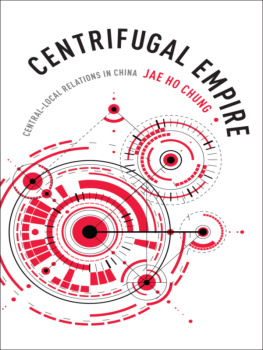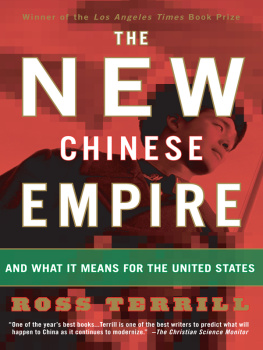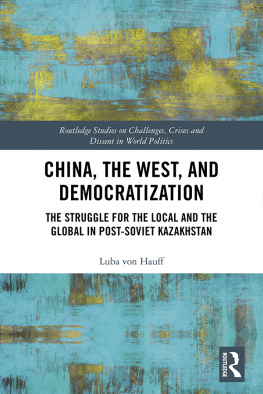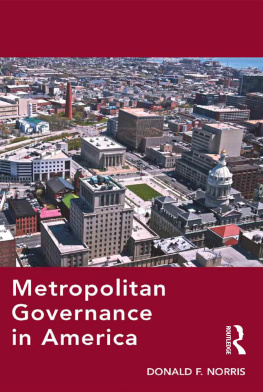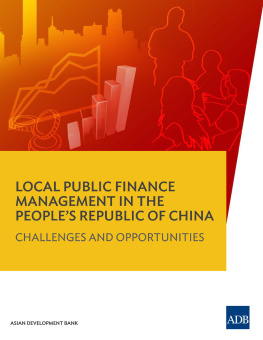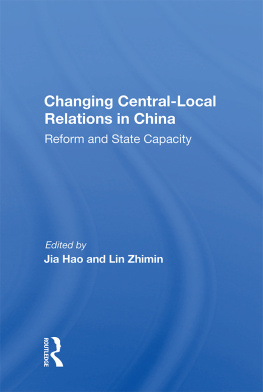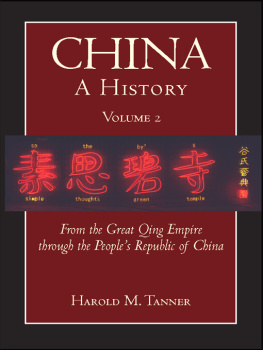Table of Contents
CENTRIFUGAL EMPIRE
CENTRIFUGAL EMPIRE
CentralLocal Relations in China
Jae Ho Chung
Columbia University Press
New York
Columbia University Press
Publishers Since 1893
New York Chichester, West Sussex
cup.columbia.edu
Copyright 2016 Columbia University Press
All rights reserved
E-ISBN 978-0-231-54068-1
Library of Congress Cataloging-in-Publication Data
Names: Chng, Chae-ho, 1960 author.
Title: Centrifugal empire : centrallocal relations in China / Jae Ho Chung.
Description: New York : Columbia University Press, 2016. | Includes bibliographical references and index.
Identifiers: LCCN 2016002533 | ISBN 9780231176200 (cloth : alk. paper) | ISBN 9780231540681 (e-book)
Subjects: LCSH: Central-local government relationsChina. | Decentralization in governmentChina. | Chinese autonomous regionsGovernment policy. | Local governmentChina. | ChinaEthnic relationsPolitical aspects. | China Politics and government2002
Classification: LCC JQ1506.S8 C46 2016 | DDC 320.80951dc23
LC record available at http://lccn.loc.gov/2016002533
A Columbia University Press E-book.
CUP would be pleased to hear about your reading experience with this e-book at .
COVER IMAGE: sylverarts/iStockphoto
COVER DESIGN: Milenda Nan Ok Lee
Contents
FIGURES
TABLES
This is my third single-authored book in English. Sixteen years since the publication of my first book on centrallocal relations with the case of rural reforms of the early 1980s, I am both happy and relieved to come back to the subject of my lifelong passion, which is also one of the most crucial and cross-cutting themes in Chinese politics. Particularly given that the number of books devoted to Chinas centrallocal dynamics has been on the decline since the late 1990s, I harbor some modest expectations that this volume will contribute to a better understanding of complex centrallocal relations in the past three decades of system reforms.
Many individuals and institutions provided invaluable support and encouragement in the long process of research and publication of this book and deserve thankful acknowledgment. Anita Chan, Bruce J. Dickson, Tao-chiu Lam, Kenneth Lieberthal, Margaret Pearson, Sangbum Shin, Dorothy J. Solinger, Jonathan Unger, and Yukyung Yeo offered critical but useful comments on different parts of the draft manuscript. Three chapters of the book were originally presented at the Asian Network for the Study of Local China (ANSLoC), which was established in 2006. I am thankful to its cofounding members and good old friendsJohn Donaldson, Phil Hsu, Tse-Kang Leng, and Long Yang in particularfor having been indispensable sources of encouragement and inspiration for the entire period of research and writing for this book.
The rewriting, editing, and refining of the manuscript benefited enormously during my third sabbatical leave (20142015) from Seoul National University. Several institutions provided financial and logistical support for research stay, as well as valuable venues where draft chapters were presented and commented on. My sincere gratitude is due the East Asian Institute (Singapore), and Gungwu Wang and Yongnian Zheng; Singapore Management University and James Tang; the University of Hong Kong, and John Burns and Peter T. Y. Cheung; Fudan Universitys School of International Studies and Zhimin Chen (I am also thankful to Ruichang Li, Yalin Tang, and Lixin Wang for offering useful comments and providing additional materials for the paper I presented there in October 2014); the Institute for Political Science at the Academia Sinica and Yu-Shan Wu; and the Samsung Economic Research Institute and Ki-Young Chung.
Some portions of is a modified version of Chinas Local Governance in Perspective: Instruments of Central Government Control, China Journal, no. 75 (January 2016).
I must also acknowledge the invaluable support (including one term of the Hysan Lee Fellowship) I received over the years from the Universities Service Center for China Studies at the Chinese University of Hong Kong. Without the archival research conducted there, this book could not have become what it is now. I thank the former and current assistant directors, Jean Hung and Gao Qi, for their unstinted support. I would also like to thank my former students Yongkai Liu, Jieun Kim, and Jongyoon Baek for research assistance. Thanks are also due three anonymous readers who read the entire manuscript for Columbia University Press. Anne Routon, my editor, was indispensable as a manager, supporter, and good friend for the entire, often painstaking process.
Last but not least, I am grateful to my wife, Hye Kyung, whose unpunctuated prayers for the last twenty-seven years made all this possible. I hope my daughter, Jean, whose interest in China and the Chinese language has been increasing over the past years, may also appreciate this book in due time.
All modern states are constructed within sovereign territories that are in principle politically monopolized, economically sustained, socially integrated, diplomatically safeguarded, and even militarily defended if necessary. Because modern states must carry out a wide range of socioeconomic functions catered to the indispensable needs of their populaces, certain degrees of political-administrative penetrationranging from nationwide taxation and conscription to public services delivery and welfare provisionare a prerequisite.
Nearly 20 percent of all states in the contemporary world have opted for a variety of federal structures in which dual (central and local) sovereignty is to be constitutionally safeguarded for the sake of protecting regional autonomy, sustaining local diversities, and coping with tensions that come with multiethnic and multicultural heritages. These federal states are generally huge in physical size, large in their population, and/or multiethnic and multicultural in their domestic compositions. Most notable examples include the United States, Russia, Canada, Brazil, and India. Despite its continental size, the worlds largest population, and highly multiethnic and multicultural attributes, the Peoples Republic of China has all along been a unitary system that allows more power for the central government at the expense of local autonomy.
One cannot help but wonder at this juncture: Why is China a unitary state after all? Furthermore, what is constantly driving China and its leadership to pledge to safeguard domestic stability and territorial integrity even at the expense of almost everything else? What are the drivers behind Chinas perennial preoccupation with effective control over localities?
Intergenerational transmissions of such memories, history, perceptions, and preoccupations have kept them still much alive in the minds of Chinese leaders residing in the Zhongnanhai.
The goal of this book is to identify, substantiate, and reconstruct such resilient perceptual undercurrents (i.e., national identities of local governance), as well as their behavioral manifestations, in the Peoples Republic, particularly during the post-Mao reform era. For that, this volume seeks to reconstruct, empirically, how the central leaders of the Peoples Republic have thought about localities and gone about designing modes of local governance. The key argument of this study is that the Communist leaders are as preoccupied as their imperial predecessors with local governance and devote as much effort to improving their capacity to control regions and provinces.

